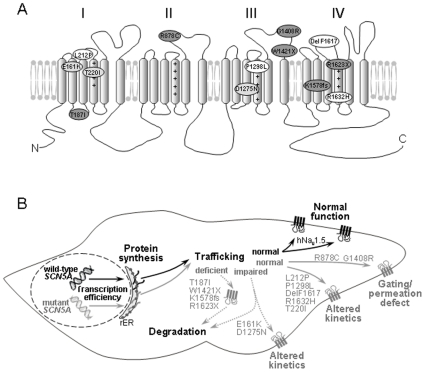XB-IMG-124989
Xenbase Image ID: 124989

|
Figure 7. Summary of the molecular mechanisms underlying SCN5A-related familial SSS.(A) Proposed membrane topology of hNav1.5 showing the locations of the thirteen SSS-associated mutations investigated here. Compared to wild-type hNav1.5, the mutant channels produced either similar (group 1, white), reduced (group 2, light grey) or no (group 3, dark grey) current. (B) Schematic representation of a sinus node cell and the cellular mechanisms involved in SCN5A-related familial SSS. Early onset of familial SSS occurred (a) when two alleles were affected (compound mutations P1298L/G1408R, DelF1617/R1632H, and T220I/R1623X) [16], or (b) when other risk factors were present (for example, a Cx40 polymorphism combined with L212P; Table 3) [34]. Notably, when wild-type hNav1.5 channels are expressed from the normal allele, most of the mutants also caused other cardiac disorders like BrS, AV block, CCD or DCM, as observed for carriers of T187I, W1421X, K1578fs/52, and E161K (see Discussion and Table 3). In most if not all of these cases, SSS onset relatively late. Image published in: Gui J et al. (2010) Gui et al. Creative Commons Attribution license Larger Image Printer Friendly View |
